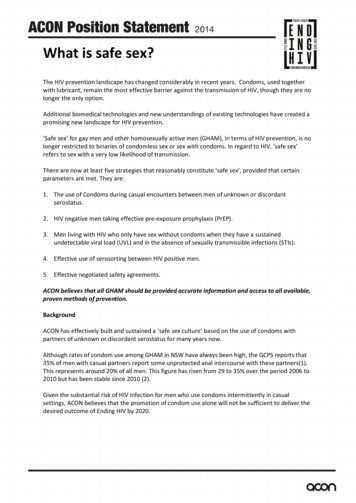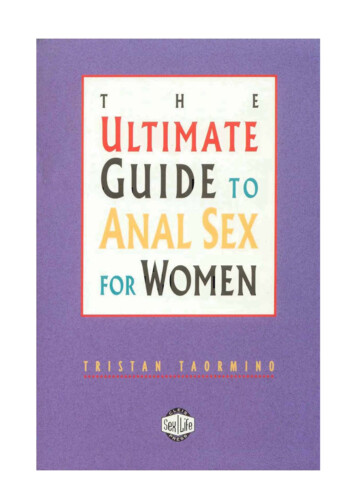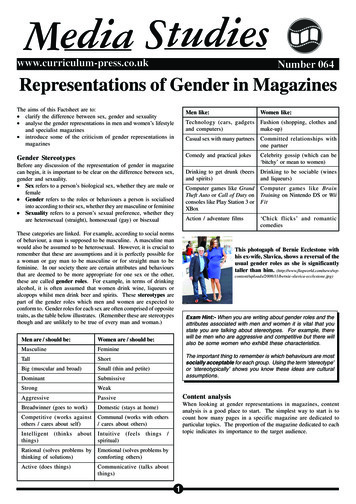
Transcription
Is sex ed goodfor your health?Story map connects health indicators to sexeducation policies across the United StatesBy: Rebekah Rollston, MD, MPH, and Gabrielle DoylePHOTO BYTERRICKS NOAH
Table of contentsIntroduction3Interpersonal violenceSexual violence5Physical dating violence7Bullying8Suicide9Sexual and reproductive healthPHOTO BYCOTTONBROContraceptive use10Sexually transmitted infections (STIs)11Teen birth12Policy and research recommendations13Conclusion15
IntroductionIn 2020, Rebekah Rollston, MD, MPH, Dave Grolling, MPSGIS,and Elizabeth Wilkinson, BA, released Sexuality EducationLegislation and Policy: A State-by-State Comparison ofHealth Indicators.Presented as a story map, the publicationexplores sex education legislation andpolicies by state when compared torespective health indicators: sexualviolence, physical dating violence, bullyingand harassment of LGB youth, suicide,contraceptive prevalence rate, sexuallytransmitted infection (STI) rate, and teenbirth rate.1 The first of its kind, this visualstory provides new insight into the impactof comprehensive sex education on thehealth outcomes of young peoplenationwide. This story map can be usedby advocates to build a case forcomprehensive sex education in their3communities. At a glance, advocates canuse this innovative tool to highlight howtheir state compares to the nationalaverage across a range of sexual healthoutcomes in addition to state sex educationmandates. While the story map reveals starkgaps in data collection on specific healthindicators, advocates are able to use thisinformation to make the case for increaseddata collection in addition to more robustsex education requirements. It can also beused as a tool for researchers to furtherdetermine how state sex education policiesimpact the health and well-being of youngpeople across the United States.PHOTO BYJULIA M CAMERON
Data for many of the health indicators arederived from the Youth Risk BehaviorSurveillance System (YRBSS), which is anational survey conducted by the Centersfor Disease Control and Prevention (CDC) inpublic and private schools throughout theUnited States.2 Not all states report on allhealth behaviors, and significantly, only tenstates and nine districts piloted a questionconcerning gender identity in the 2017survey.3 As a result, there are limitations tothe observations and correlations withinthe story map. This discrepancy underscoresthe need for more rigorous scientific data todemonstrate the positive health outcomesthat result from comprehensive sexeducation.Comprehensive sex education (CSE)programs are school-based, start inkindergarten, and continue through grade 12.Comprehensive sex education programsinclude developmentally and culturallyresponsive, science-based, and medicallyaccurate information on a broad set oftopics related to sexuality, including humandevelopment, relationships, personal skills,sexual health, and society and culture.CSE programs provide students withopportunities for learning information,exploring their attitudes and values, andPHOTO BYLUIS QUINTEROdeveloping skills. CSE teaches critical lifeskills and is a powerful tool for addressingreproductive justice, gender equity, lesbian,gay, bisexual, transgender, and queer(LGBTQ) equality, violence prevention, andpower and oppression.4 Currently, 29 statesmandate sex education for young peoplein schools.5 1Rollston, R., Grolling, D., Wilkinson, E. (2020). Sexualityeducation legislation and policy: a state-by-state comparisonof health indicators. ArcGIS. 5c092eb020f437267652Youth Risk Behavior Surveillance System (YRBSS). (2018).Centers for Disease Control and Prevention ndex.htm3Johns, M.M., Lowry, R., Andrzejewski, J., et al. (2019).Transgender identity and experiences of violencevictimization, substance use, suicide risk, and sexual riskbehaviors among high school students—19 states and largeurban school districts, 2017. MMWR. m4National Sex Education Standards: Core Content and Skills,K-12 (2nd edition). (2020). Future of Sex Education t/uploads/2020/03/NSES-2020-web.pdf5Sex ed state law and policy chart. (2020). SIECUS: Sex Edfor Social Change. 3.pdf4
Interpersonal violencea. Sexual violenceReported rates of sexual violence by womenhave gradually decreased since 1995.6Despite this positive trend, an average of400,000 cases of sexual assault are reportedeach year, and the majority of survivors ofsexual assault report being victimized forthe first time before the age of 25 years old.7Young women aged 16-19 are four timesmore likely than the general population tobe survivors of rape, attempted rape, orsexual assault. It is also reported that lesbian,gay, and bisexual (LGB) youth experiencesexual violence at over double the rate oftheir heterosexual peers.2 While not widelycaptured in the 2017 YRBSS due to the newnature of its inclusion in the questionnaire,transgender youth in particular experiencedisproportionate rates of sexual violence.According to the 2015 U.S. TransgenderSurvey, 13% of transgender and genderexpansive people reported being sexuallyassaulted in grades K-12 and cited theirgender identity as the cause of the attack.8PHOTO BYCOTTONBROWhile young women and LGBTQ youth makeup the vast majority of reported youngpeople who experience sexual violence,nationwide mandates concerning instructionon sexual violence prevention areoverwhelmingly insufficient. Of the statesthat report to the YRBSS on sexual violence,only California and New Hampshiremandate students be taught about consent;notably, both California and New Hampshirehave sexual violence rates below thenational average.1 Right now, only ninestates (California, Colorado, Hawaii,Illinois, Maryland, Missouri, Oklahoma,Virginia, and Washington) mandatestudents be taught about consent.5Furthermore, within healthy relationshipscurriculum, 21 states do not mandateinstruction on violence prevention.5While instruction on consent varies greatlydepending on the state, certain statesprovide a more comprehensive definition ofwhat must be included in consent curriculum.For example, in Illinois, educators must5
provide an age-appropriate discussion onthe meaning of consent that recognizes thefollowing9:A. consent is a freely given agreement tosexual activity.B. consent to one particular sexual activitydoes not constitute consent to othertypes of sexual activities.C. a person’s lack of verbal or physicalresistance or submission resulting fromthe use or threat of force does notconstitute consent.D. a person’s manner of dress does notconstitute consent.E. a person’s consent to past sexualactivity does not constitute consent tofuture sexual activity.F. a person’s consent to engage in sexualactivity with one person does notconstitute consent to engage in sexualactivity with another person.G. a person can withdraw consent atany time.H. a person cannot consent to sexualactivity if that person is unable tounderstand the nature of the activityor give knowing consent due to certaincircumstances that include, but are not6limited to, (i) the person is incapacitateddue to the use or influence of alcohol ordrugs, (ii) the person is asleep orunconscious, (iii) the person is a minor,or (iv) the person is incapacitated dueto a mental disability.9The story map reveals an unclear relationshipbetween sex education legislation andsexual violence among high school students,which is due to a large number of statesfailing to report on this measure in theYRBSS.1 Moreover, comprehensive sexeducation within the United States hashistorically not been recognized as thepowerful tool for violence prevention thatwe know it is. While some studies haverevealed the connection between sexualviolence prevention and sex education,more robust research is essential tostrengthen this relationship.10 The absenceof such data may be a byproduct of theinability to recognize the power ofcomprehensive sex education as violenceprevention.A comprehensive sex education programthat meets the National Sex EducationStandards has the potential to preventsexual violence perpetration for manyreasons, including that sexual violence riskfactors have been shown to be mitigatedthrough educational interventions.10 Further,beginning comprehensive sex educationprograms in kindergarten is critical. At thisearly point in the life course, a number ofrisk factors begin to develop. Througheducating young children, sex educators canaddress sexual violence before it occurs.106Planty, M., Langton, L., Krebs, C., et al. (2016). Female victims ofsexual violence, 1994-2010. U.S. Department of Justice. mith, S.G., Zhang, X., Basile, K.C., et al. (2018). National intimatepartner and sexual violence survey: 2015 data brief—updatedrelease. Centers for Disease Control and Prevention 015data-brief508.pdf8James, S.E., Herman, J.L., Rankin, S., et al. (2016). The Report ofthe 2015 U.S. Transgender Survey. National Center forTransgender Equality. /usts/USTS-Full-Report-Dec17.pdf9An Act Concerning Education: Public Act 101-0579. (eff. 01/PDF/101-0579.pdf10Schneider, M., Hirsch, J.S. (2018). Comprehensive sexualityeducation as a primary prevention strategy for sexual violenceperpetration. Trauma, Violence, and Abuse, 21(3), 439-455.https://doi.org/10.1177/152483801877285
b. Physical dating violenceinstruction on healthy relationships.5Within healthy relationships curriculum,only 24 states mandate instruction oncommunication skills.5On average, one in 10 high school studentshave experienced physical dating violencefrom an intimate partner in the past year.11One in nine of these students are youngwomen, and one in 36 are young men.2Among all youth, Black women report thehighest rates of experiencing physicaldating violence at 13.1%.2 Similar to datasurrounding sexual violence, LGB studentsreport experiencing physical datingviolence at over double the rate of theirheterosexual peers.2The story map demonstrates that a largenumber of states do not report on physicaldating violence in the YRBSS.1 Of theavailable data, the national average forphysical dating violence reported amonghigh school students is 8.53%.2Though the story map reveals an unclearrelationship between sex educationlegislation and physical dating violence,this lack of concrete data underscores theneed for additional rigorous, large-scalescientific research that further demonstratescomprehensive sex education as apowerful vehicle for violence prevention.11Dating Matters: strategies to promote healthy teenrelationships. (2012). Centers for Disease Control andPrevention (CDC). atters flyer 2012-a.pdfWhile these staggering rates helpemphasize the urgent need for advancedinstruction on healthy relationships andviolence prevention within sex education,states continue to fall behind. Right now,only 22 states mandate some instruction onhealthy relationships, and only nine states(California, Colorado, Hawaii, Illinois,Maryland, New Mexico, Oregon, Texas,and Vermont) mandate comprehensive7PHOTO BYJERMAINE ULINWA
c. BullyingBullying remains an urgent public healthconcern with 20% of high school studentsreporting being bullied on school propertyin the last year.12 People bully for manyreasons, though primary motives includelow self-esteem, emotional neglect, andsome bullies may be victims of violencethemselves.13Discriminatory school policies furtherexacerbate the adverse conditions manyLGBTQ youth are forced to tolerate on adaily basis. Right now, only 11 states havepolicies that include affirming instructionon LGBTQ identities.5Of the states that report in the YRBSS,the story map indicates Oklahoma has thehighest rate of LGB students who reportbeing bullied (48.3%), and Oklahoma alsomandates students be taught thathomosexual behaviors are the primarycause for HIV/AIDS.1Alabama, Arizona, Mississippi, Oklahoma,and Utah mandate students be taughtnegative outcomes of homosexuality(e.g. teachers cannot “suggest that somemethods of sex are safe methods ofhomosexual sex”).1 Notably, in Arizona,840.9% of LGB high school students reportbeing bullied (compared to the nationalaverage of 34.01%).2 Alabama, Mississippi,and Utah have sex education legislationthat mandates students be taught negativeoutcomes of homosexuality, though thesestates do not report on bullying in theYRBSS.1 North Carolina includes languagein their sex education legislation thatpromotes a heterosexual standard but doesnot directly mandate negative depictions ofhomosexuality.1 Notably, a previous lawprohibited discussion of LGBTQ topics inSouth Carolina, though in March 2020, a U.S.district judge ruled this unconstitutional.14While students of all demographics reportbeing bullied, LGB students report beingbullied at significantly higher rates than theirheterosexual peers. For instance, 70.1% ofLGB youth reported experiencing verbalharassment in 2017.15 Additionally, 77% ofthose who were perceived as transgenderreport having one or more negativeexperiences at school because of theirperceived transgender identity, includingverbal harassment and physical violence.3Increased rates of bullying can contribute toadverse health outcomes for LGB youth.16Though observable patterns within thestory map are limited due to many statesnot reporting in the YRBSS, the datademonstrate that many states lack formalmandates for sex education that areinclusive of the full spectrum of genderidentity and sexual orientation.112Preventing bullying. (2019). Centers for Disease Control andPrevention (CDC). ying-factsheet508.pdf13Swearer, S.M., Hymel, S. (2015). Understanding the psychologyof bullying: moving toward a social-ecological diathesis–stressmodel. American Psychologist. 38929.pdf14Knox, L. (2020). S. Carolina law banning LGBTQ sex ed isunconstitutional, judge rules. NBC. les-n115650115Kosciw, J.G., Greytak, E.A., Zongrone, A.D., et al. (2018).The 2017 National School Climate Survey: the experiences oflesbian, gay, bisexual, transgender, and queer youth in ournation’s schools. GLSEN. -Report.pdf162018 LGBTQ Youth Report. (2018). Human Rights urces/2018-YouthReport-NoVid.pdf? ga 243
d. Suicidecompared to gay and bisexual malestudents (37.0%).2 Transgender youth alsoexperience disparate rates of suicidalideation, with an overwhelming 35% oftransgender youth reporting that theyhave attempted suicide.3Suicide was the second leading cause ofdeath among young people in 2017.17Between 2008 to 2015, hospital admissionsfor suicidal ideation and attempts amongyoung people more than doubled.18 Youngwomen report seriously considering suicideat nearly twice the rate of their male peers,and LGB youth report seriously consideringsuicide at over three times the rate oftheir heterosexual peers.2 Such devastatingindicators do not exist in a vacuum, asassociated health factors like bullying anddating violence underscore this disparateimpact on young women and lesbian, gay,and bisexual youth.As noted in the story map, it is difficult tountangle the relationship between sexeducation legislation and suicidal ideationgiven the breadth of this particular indicator.1Analyses of YRBSS data demonstrate that47.7% of LGB youth had seriously consideredattempting suicide compared to 13.3% oftheir heterosexual peers.2 Further, theprevalence of suicidal ideation is higheramong heterosexual female students (16.9%)compared to heterosexual male (10.2%)students.2 It is also higher among lesbianand bisexual female students (51.0%)9Because comprehensive sex educationprovides affirming instruction on sexualorientation and gender identity, along withinstruction on healthy relationships,self-esteem, body confidence, and personalsafety, it has the powerful potential to actas a method of suicide prevention.Again, the lack of rigorous, large-scalescientific research that demonstrates thecorrelation between comprehensive sexeducation and suicide is likely a byproductof the inability to recognize the power ofsex education as violence prevention. Whileearly data suggest that comprehensive sexeducation can successfully address violenceprevention, further data is needed tounderscore this correlation.1 17Heron, M. (2019). Deaths: leading causes for 2017. Centersfor Disease Control and Prevention (CDC) NVSR, 68(6). https://www.cdc.gov/nchs/data/nvsr/nvsr68/nvsr68 06-508.pdf18Plemmons, G., Hall, M., Doupnik, S., et al. (2018).Hospitalization for suicide ideation or attempt: 2008-2015.Pediatrics, 141(6). /6/e20172426PHOTO BYCOTTONBRO
Sexual and reproductive healtha. Contraceptive useContraceptive prevalence refers to thepercentage of high school students whoreported using any form of contraceptionprior to their last sexual intercourse. Whilethe rate of contraceptive prevalence is againmultifactorial, the nationwide patchwork ofsex education requirements likely influencescontraceptive use. Right now, only 16states require instruction on condoms orcontraception, if sex education is provided.5The primary observable pattern thatemerges within the story map is that stateswith the lowest rates of contraceptiveprevalence—Texas, Arkansas, and Nevada—do not mandate contraceptive education.1Further, an overwhelming 35 states requireschools to stress abstinence when sexeducation or HIV/STI instruction is provided.5Moreover, while contraceptive use isessential in preventing unintended pregnancyand the spread of STIs when condoms areused, access to health centers that offer the10full range of contraceptives varies greatlyacross the United States. Nineteen millionwomen currently live in counties where theylack reasonable access to health centersthat offer the full range of contraceptivemethods.19 These areas are referred to ascontraceptive deserts. Even further,1.6 million women live in counties withouta single health center that offers the fullrange of contraceptive options.19to such legislative advancements, it isessential that young people have the meansto access healthcare providers in theirrespective communities that allow themto obtain said contraception. Without themeans to access reproductive healthcareservices, education on contraception isrendered ineffective.19While contraceptive use among youngpeople has increased since the 1990s,contraceptive prevalence continues to beinconsistent. In 2017, 18% of U.S. highschool women reported they were eitherunsure if they used birth control or theyused no method at all during their lastsexual intercourse.2As indicated by observable patterns withinthe story map, legislation that requiresstudents be taught about contraception hasthe potential to improve contraceptiveprevalence among adolescents.1 In additionBirth control access. (2020). Power to Decide. control-access
b. Sexually transmitted infections (STIs)In recent years, reported rates of sexuallytransmitted infections have continued toincrease across the United States. In 2018,nearly 2.5 million cases of chlamydia,gonorrhea, and syphilis were reported.20Young people aged 15-24 made up almosttwo thirds of all reported chlamydiacases.20 While STIs have impactedcommunities nationwide, young people inparticular continue to be disproportionatelyrepresented among reported cases.Currently, young people represent anestimated half of all reported STI casesannually and 62% of all chlamydia cases,despite representing only 13% of thepopulation.20However, STI education continues to beneglected in schools nationwide. Fifteenstates do not require sex education orHIV/STI instruction to be age-appropriate,medically accurate, culturally responsive,or evidence-based.5 Fourteen states donot require HIV/STI education at all.5Further, observable patterns within thestory map demonstrate that STI rates arelowest in Vermont, New Hampshire, Maine,West Virginia, Utah, and Idaho—five ofthese six states mandate sex education(Idaho being the exception).1 Geographic11observations within the story map revealthat STI rates are particularly high throughout much of the country’s Southeast andMidwest regions.1 Mississippi and Louisiana,in particular, report the highest STI ratescompared to other states. Mississippi doesnot mandate HIV/STI education, andLouisiana does not mandate sex educationor HIV/STI education at all.1,5Moreover, additional disparities exist amongreported STI cases that demonstrate thestark gap in access to preventive care forcommunities of color and men who havesex with men (MSM). In 2018, the rate ofreported chlamydia cases among Blackmen aged 15-19 was 9.1 times higher thanthe rate of their white peers.21 The rateamong Black women aged 15-19 was 4.5times higher than the rate reported amongtheir white peers.21 Similar racial disparitiesare reported for American Indians/AlaskaNatives (3.7 times the rate among whites),Native Hawaiians and other Pacific Islanders(3.3 times the rate among whites and 5.3times the rate among Asians) and Hispanics(1.9 times the rate among whites).21 Whilesimilar rates regarding young men who havesex with men are not readily available, MSMaccounted for 68.2% of reported primaryand secondary syphilis cases in 2017.22As indicated by observable patterns withinthe story map, legislation that requires sexeducation and HIV/STI instruction to bemedically accurate, culturally responsive,and evidence-based directly addresses thisepidemic that disproportionately impactsyoung people, communities of color, andmen who have sex with men.120Sexually Transmitted Disease Surveillance 2018. Centers forDisease Control and Prevention (CDC). https://www.cdc.gov/std/stats18/toc.htm21Sexually Transmitted Disease Surveillance 2018: Racial andethnic minorities. Centers for Disease Control and Prevention(CDC). xually Transmitted Disease Surveillance 2017: Men whohave sex with men. Centers for Disease Control and Prevention(CDC). https://www.cdc.gov/std/stats17/msm.htm
While the explanation for the decline inteen birth rate is multifactorial, some of therationale may be attributed to stronger sexeducation policies across the country andaccess to contraception options madeavailable through services such as theAffordable Care Act. c. Teen birthTeen birth rate in the United States hashistorically been among the highest in thedeveloped world. While it has dramaticallydecreased over time, the United Statesteen birth rate still remains high comparedto other developed countries.1 Between1991-2005, the U.S. teen birth rate declinedby more than a third, from 62 births per1,000 women aged 15-19 years to 40 birthsper 1,000 women aged 15-19 years old.23Despite rapid declines in teen birth ratesacross all major racial and ethnic groups,disparities continue to persist. In 2018, thebirth rate among Hispanic and Black teensaged 15-19 was almost double the rate ofwhite teens and more than five times therate among Asians and Pacific Islanders.2423Key facts about teen births. (2019). Child -births24Trends in teen pregnancy and childbearing. (2019).U.S. Department of Health & Human Services Office ofPopulation Affairs. ncy-and-childbearing/trends/index.htmlObservable patterns emerge within the storymap between sex education legislation andteen birth rate. Teen birth rates appear tobe lowest in the Northeast, as well as inMinnesota.1 Of the states with the lowestteen birth rates (less than 12.5 births per1,000 women aged 15-19), six out of sevenstates mandate sex education (Connecticut,Minnesota, New Hampshire, New Jersey,New York, Vermont).112PHOTO BYPANDU DUNIA
Policy and researchrecommendationsAccess to comprehensive sex education can be a reality foryoung people nationwide through implementation ofcomprehensive policies at the federal, state, and local levels.Advanced sex education policies, coupled with substantialfunding, educator training and development, and robustreporting requirements, can provide the quantitative dataneeded to further demonstrate the relationship betweencomprehensive sex education and health outcomes amongyoung people.PHOTO BYOLADIMEJI AJEGBILE13
Federal Demand Congress pass the RealEducation for Healthy Youth Act (S.1524/H.R. 2720), which would create thefirst-ever federal funding stream forcomprehensive sex education nationwideand would prohibit funding for failedabstinence-only programming. Demand Congress pass the Youth Accessto Sexual Health Services Act (S.1530/H.R.2701), which would provide communitygrants to increase and improve access tosexual and reproductive healthcare andrelated services for young people of color,immigrant youth, LGBTQ youth, youth infoster care, youth experiencinghomelessness, youth in juvenile detention,and otherwise marginalized young people. Ensure that the Centers for DiseaseControl and Prevention (CDC) Divisionof Adolescent and School Health (DASH)expands the Youth Risk BehaviorSurveillance System (YRBSS) to includequestions related to gender identity andsexual orientation, following results fromthe 2017 pilot question on genderidentity implemented across 19 statesand localities.14 Demand Congress include appropriationsto increase federal funding for programsthat advance sex education nationwide(e.g. DASH) and eliminate funding forabstinence-only, “sexual risk avoidance”programming.State Pass statewide comprehensive sexeducation mandates. Require the State Department ofEducation to align statewide sex educationcurriculum requirements with the NationalSex Education Standards. Allocate additional funding for theimplementation of comprehensive sexeducation and educator training inappropriations for each fiscal year. Mandate accountability and oversightrequirements to track the implementationprogress of sex education and collectaggregate data on topics taught. Allocate substantial funding to ensureeducators are trained in accordance withthe National Teacher PreparationStandards for Sexuality Education.Local Work with local school boards toimplement comprehensive sex educationpolicies. Utilize the SIECUS Community ActionToolkit to foster community involvementin advancing sex education requirements. Ensure educators are trained accordingto the National Teacher PreparationStandards for Sexuality Education.Research recommendations Advocate to make sex education-relatedYRBS questions mandatory for all states. Advocate for additional surveillance andmonitoring questions on national andstatewide CSE program evaluations inorder to track health and behavioroutcomes beyond pregnancy anddisease prevention. Issue a call to action for research thatfocuses on positive health, behavior,and social inclusion outcomes ofcomprehensive sex education.
ConclusionThe Sexuality Education Legislation and Policy: A State-byState Comparison of Health Indicators story mapdemonstrates a range of health indicators that are affectedby comprehensive sex education policies nationwide.While many observable patterns emergewhen comparing health indicators and sexeducation requirements, clear gaps in datainhibit the definitive analysis of the impactof comprehensive sex education on sexualviolence, physical dating violence, bullyingand harassment of LGB youth, suicide,contraceptive prevalence rates, STI rates,and teen birth rates.Through the advancement of uniformstatewide and national comprehensive sexeducation policies and continuedparticipation in surveys like the YRBSS,these correlations may be further clarifiedto underscore the importance ofcomprehensive sex education. 25To build upon current research thatdemonstrates the correlation betweencomprehensive sex education and positivehealth outcomes among young people, thecollection of additional data is essential.2515Building a foundation for sexual health is a K-12 endeavor:evidence underpinning the National Sexuality EducationStandards. (2019). Future of Sex Education -Health.pdfPHOTO BYRENEE CLANCY
16www.siecus.org
dating violence at 13.1%.2 Similar to data surrounding sexual violence, LGB students report experiencing physical dating violence at over double the rate of their heterosexual peers.2 The story map demonstrates that a large number of states do not report on physical dating violence in th











